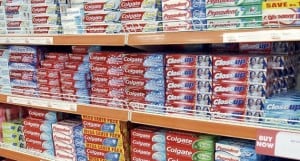 When you squeeze your strip of toothpaste on to your toothbrush in the morning, you probably aren’t concerned with how it all started. We have come a long way since the first oral hygiene pastes were used. It is believed that toothpastes, in some form or another, have been around longer than the toothbrush. Egyptians have been using a paste since ~5000 BC consisting of ash of ox hooves, burnt eggshells and pumice. Meanwhile, Greeks and Romans preferred a more abrasive paste and used crushed bones and oyster shells. These pastes were used for similar reasons as today’s toothpastes: to clean and whiten teeth, and freshen breath.
When you squeeze your strip of toothpaste on to your toothbrush in the morning, you probably aren’t concerned with how it all started. We have come a long way since the first oral hygiene pastes were used. It is believed that toothpastes, in some form or another, have been around longer than the toothbrush. Egyptians have been using a paste since ~5000 BC consisting of ash of ox hooves, burnt eggshells and pumice. Meanwhile, Greeks and Romans preferred a more abrasive paste and used crushed bones and oyster shells. These pastes were used for similar reasons as today’s toothpastes: to clean and whiten teeth, and freshen breath.
 In the 1800’s, the first produced toothpaste contained soap, chalk, and eventually charcoal, and came in a powder form. By 1850, toothpaste actually became a paste and was sold in jars using the trade name ‘crème dentifrice.’ Colgate was the first to mass produce toothpaste in jars and developed the familiar tube in the 1890’s.
In the 1800’s, the first produced toothpaste contained soap, chalk, and eventually charcoal, and came in a powder form. By 1850, toothpaste actually became a paste and was sold in jars using the trade name ‘crème dentifrice.’ Colgate was the first to mass produce toothpaste in jars and developed the familiar tube in the 1890’s.
1945 was a revolutionary time for toothpaste because soap was no longer added. Instead, other ingredients were used to make the paste smooth. Disease prevention and treatment also became popular. The first fluoridated toothpastes were seen around 1914 and harsh abrasives were removed. In the latter part of the century, triclosan and potassium nitrate were included in the formulation for reduction of bacteria and tooth sensitivity. This brings us to the current toothpastes available on the market that offer many flavors and brands. A true staple for your daily oral hygiene routine!
part of the century, triclosan and potassium nitrate were included in the formulation for reduction of bacteria and tooth sensitivity. This brings us to the current toothpastes available on the market that offer many flavors and brands. A true staple for your daily oral hygiene routine!
Source: Colgate.com
Written by: Tishena, lead assistant at White Dental Studio in Ashland, OR

Recent Comments